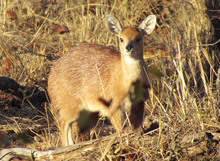- Sharpe's Grysbok
-
Sharpe's Grysbok 
Female, Kruger National Park Conservation status Scientific classification Kingdom: Animalia Phylum: Chordata Class: Mammalia Order: Artiodactyla Family: Bovidae Genus: Raphicerus Species: R. sharpei Binomial name Raphicerus sharpei
Thomas, 1897 A Sharpe's Grysbok in the Kruger National Park
A Sharpe's Grysbok in the Kruger National Park
Sharpe's or Northern Grysbok (Raphicerus sharpei) is a small, shy, solitary antelope of south-eastern Africa—Transvaal (South Africa), Caprivi Strip (Namibia), Botswana, Mozambique, Zimbabwe, Zambia, Malawi and Tanzania to Lake Victoria.
It is similar in size to the Gray Duiker, but has a stockier body and elongated fur over the hindquarters. It stands about 20" (45–60 cm) at the shoulders and weighs only 7–11.5 kg. Its coat is reddish-brown which is streaked with white; eye-rings, around mouth, throat and underside are off-white. The males have stubby horns, which are widely spaced. Sharpe's Grysbok has a short deep muzzle with large mouth and heavy molar (grinding) teeth. The short neck and face on a long-legged body result in a high-rump posture when browsing.
Although its territorial range is large, Sharpe's Grysbok is infrequently seen. Males and females seem to form brief associations, but the species is usually encountered singly. Territory is marked with dung middens. Their habitat is rocky hill country, but preferring fertile zones on the lower slopes. They are nocturnal browsers and spend the day in the protective cover of tall grass or shrubs. They are extremely timid and will run away at the first sign of anything unusual, although this flight is accompanied "short stamping hops"[2]; they move well away from where the disturbance occurred before stopping (unlike Steenbok, which stop and look back)[3]. Sharpe's Grysbok are reported to take refuge in Aardvark burrows, like Steenbok.
Sharpe's Grysbok browse on leaves, buds, herb and fruits—in the dry season, their food is typically tough (for which their teeth and jaws are adapted). Grazed grass makes up about 30% of their diet[2].
The closely related Cape (or Southern) Grysbok (R. melanotis) occurs in the western Cape region. Haltenorth and Diller[4] consider sharpei as a subspecies of melanotis.
References
- ^ IUCN SSC Antelope Specialist Group (2008). Raphicerus sharpei. In: IUCN 2008. IUCN Red List of Threatened Species. Downloaded on 29 March 2009. Database entry includes a brief justification of why this species is of least concern.
- ^ a b Kingdon, Jonathan. 1997. The Kingdon Field Guide to African Mammals. Academic Press, San Diego & London. Pp. 386-387. (ISBN 0-12-408355-2)
- ^ Smithers, Reay H.N. 1971. The Mammals of Botswana. Museum Memoir No. 4. The Trustees of the National Museum of Rhodesia, Salisbury [Harare], Rhodesia [Zimbabwe]. Pp. 221–222.
- ^ Haltenorth, Theodor and Helmut Diller. 1980. A Field Guide to the Mammals of Africa including Madagascar. Collins, London. Pp. 53–54. (ISBN 0-00-219778-2)
- Ellerman, J.R., T.C.S. Morrison-Scott and R.W. Hayman. 1953. Southern African Mammals 1758 to 1951: A Reclassification. British Museum (Natural History), London. P. 186.
External links
Categories:- IUCN Red List least concern species
- Dwarf antelopes
- Mammals of Africa
- Fauna of South Africa
- Fauna of Namibia
- Fauna of Botswana
- Fauna of Zambia
- Fauna of Zimbabwe
- Fauna of Swaziland
- Fauna of Mozambique
- Fauna of East Africa
- Fauna of Tanzania
Wikimedia Foundation. 2010.

